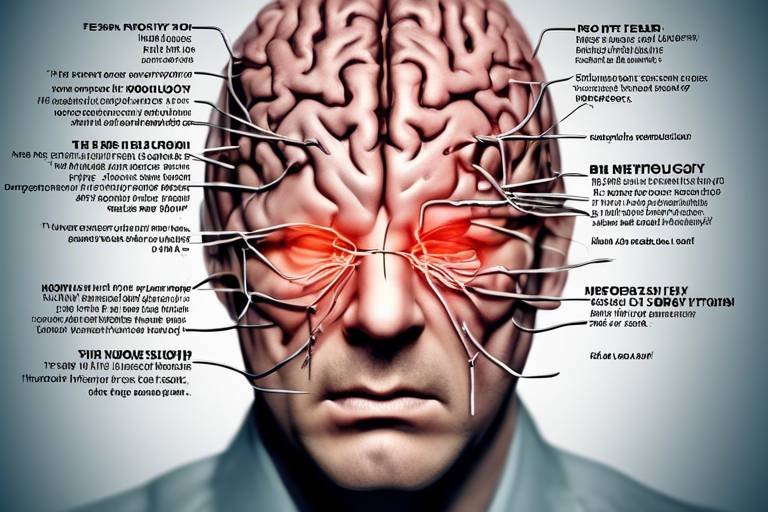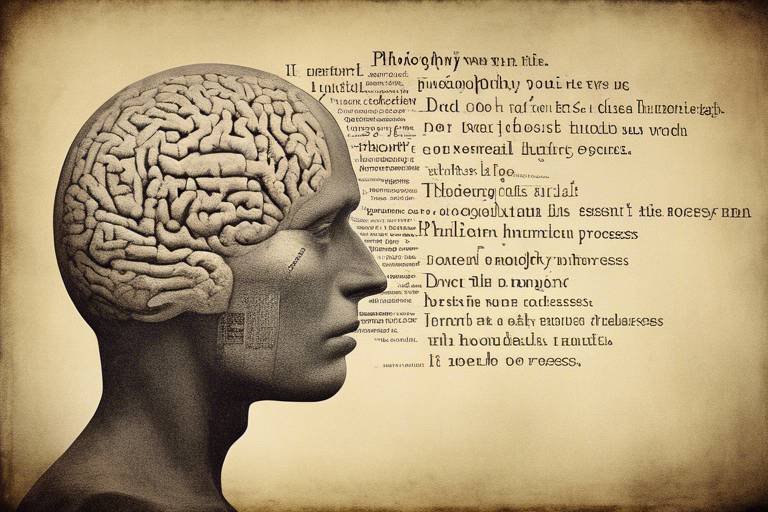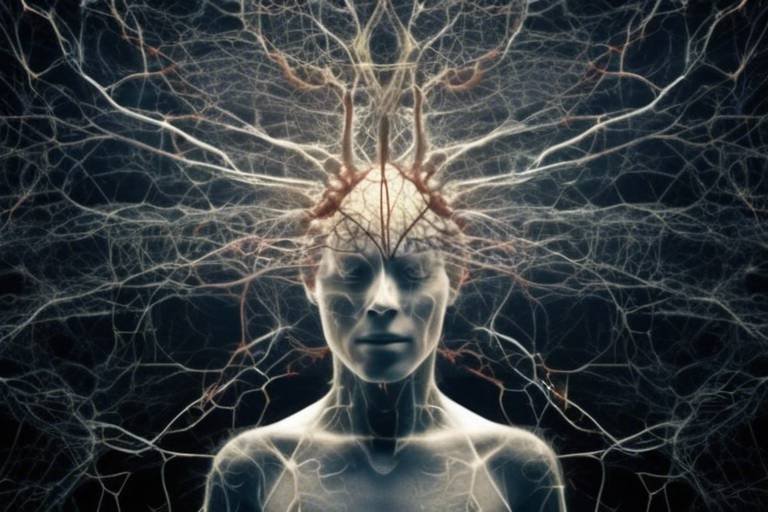The Neurology of Fear - How Does the Brain Process Threat?
Fear is a primal emotion that has safeguarded humanity for eons, acting as a protective mechanism against potential dangers. But have you ever wondered how this intricate emotion is processed in the brain? The journey of fear starts in the brain's complex circuitry, where various structures work in concert to interpret and respond to threats. Understanding this process not only sheds light on human behavior but also opens the door to addressing mental health issues that arise from fear responses.
At the core of fear processing lies the amygdala, a small almond-shaped cluster of nuclei located deep within the temporal lobe. This critical brain region acts as the brain's alarm system, detecting threats and triggering appropriate responses. But the amygdala does not work alone; it collaborates with the hippocampus, which plays a vital role in forming memories, and the prefrontal cortex, which helps regulate emotional responses. Together, these structures create a dynamic feedback loop that shapes how we perceive and react to fear.
When faced with a potential threat, the amygdala quickly evaluates the situation, often before we even have a chance to consciously process it. It sends signals to the hypothalamus, which activates the fight-or-flight response, flooding the body with stress hormones like adrenaline and cortisol. This rapid response is akin to hitting the brakes in a car when you see an impending collision. It’s all about survival. But what happens when this system goes awry? Understanding the neurological pathways involved in fear can help us unravel the complexities of anxiety disorders and other mental health issues.
Moreover, the interplay between these brain regions creates a fascinating tapestry of emotional responses. The hippocampus not only helps in forming memories related to fear but also contextualizes them, allowing us to learn from past experiences. For instance, if you were bitten by a dog as a child, the amygdala will remember that fear, while the hippocampus provides context, helping you avoid similar situations in the future. This is where conditioned fear responses come into play, illustrating how our brain learns to associate certain stimuli with danger.
However, fear is not just about reacting; it's also about regulation. The prefrontal cortex, often referred to as the brain's executive center, plays a crucial role in modulating fear responses. It helps us assess situations more rationally, allowing us to distinguish between real threats and mere perceptions of danger. This regulation is essential for healthy emotional functioning, as excessive fear can lead to avoidance behaviors that hinder daily life. Imagine trying to cross a busy street while being paralyzed by fear—this is where the prefrontal cortex comes in, helping us navigate our fears and make informed decisions.
In conclusion, the neurology of fear is a complex interplay of various brain structures that work together to ensure our survival. By understanding how the brain processes threats, we can better appreciate the nuances of human behavior and the implications for mental health. Fear, while often viewed negatively, is an essential part of our emotional landscape, and learning to manage it can lead to healthier outcomes.
- What is the primary function of the amygdala? The amygdala is primarily responsible for processing emotions, particularly fear, and triggering the body's fight-or-flight response.
- How does the hippocampus relate to fear? The hippocampus helps form memories related to fear and provides context for those memories, allowing us to learn from past experiences.
- What role does the prefrontal cortex play in fear responses? The prefrontal cortex regulates emotional responses, helping individuals assess threats more rationally and mitigating excessive reactions.
- Can fear lead to anxiety disorders? Yes, dysregulation in the brain's fear circuitry can contribute to anxiety disorders, including PTSD and generalized anxiety disorder.

The Brain's Fear Circuitry
Understanding the brain's fear circuitry is like peeling back the layers of an onion; each layer reveals intricate connections that contribute to our emotional responses. At the heart of this circuitry lies the amygdala, a small almond-shaped structure that acts as the brain's alarm system. When we encounter a potential threat, the amygdala springs into action, processing sensory information and determining whether a situation is dangerous. But it doesn't work alone. The hippocampus and the prefrontal cortex also play vital roles in how we interpret and react to fear.
The amygdala is primarily responsible for the immediate, instinctive reaction to fear. When it detects a threat, it triggers a cascade of responses, including the release of stress hormones like adrenaline and cortisol. This is where the fight-or-flight response kicks in, preparing our bodies for immediate action. Imagine walking in the woods and suddenly spotting a snake; your heart races, your muscles tense, and you're ready to either flee or confront the danger. This rapid response is crucial for survival, but it’s just the tip of the iceberg.
The hippocampus, on the other hand, is essential for contextualizing fear. It helps us remember past experiences and understand the context of the threat. For instance, if you were once bitten by a dog, your hippocampus stores that memory, allowing you to recognize similar situations in the future. This is why we often feel anxious around unfamiliar dogs; our brain is trying to protect us based on previous experiences.
Meanwhile, the prefrontal cortex acts as a regulatory force, helping us make sense of our emotional responses. It evaluates the situation, weighing the potential risks and benefits before we react. This part of the brain is what allows us to think rationally and make informed decisions, instead of simply reacting out of fear. For example, if you see a barking dog, your prefrontal cortex might remind you that not all dogs are dangerous, prompting a more measured response.
To visualize this complex interplay, consider the following table that outlines the roles of these key brain structures in fear processing:
| Brain Structure | Function |
|---|---|
| Amygdala | Detects threats and triggers fear responses. |
| Hippocampus | Stores memories and contextualizes fear. |
| Prefrontal Cortex | Regulates emotional responses and aids in decision-making. |
In summary, the brain's fear circuitry is a complex network of structures that work together to process threats. The amygdala, hippocampus, and prefrontal cortex each contribute in unique ways, shaping our emotional responses and influencing our behavior. Understanding these mechanisms not only sheds light on how we respond to fear but also has important implications for mental health, particularly in the context of anxiety disorders and phobias.

When it comes to fear, our brain isn't just passively observing; it's actively engaged in a complex dance of neurotransmitters that dictate how we perceive and respond to threats. Neurotransmitters are like the messengers of the brain, carrying signals that can either heighten our sense of danger or help us calm down. Two of the most significant players in this fear response are adrenaline and cortisol, both of which are released during stressful situations.
Adrenaline, also known as epinephrine, is responsible for the immediate physical reactions we often associate with fear. Imagine you're walking in the woods and suddenly spot a bear. Your body doesn't just sit there; it springs into action. Adrenaline floods your system, increasing your heart rate and blood pressure, preparing you for a quick escape or a fight. This rush is often referred to as the "fight-or-flight" response, a survival mechanism that has been ingrained in us through evolution.
Cortisol, on the other hand, is the body's primary stress hormone. Released in response to stress, it helps regulate various functions, including metabolism and immune response. However, when cortisol levels remain elevated due to chronic stress or prolonged fear, it can lead to a host of health problems, including anxiety disorders and depression. In essence, while cortisol is essential for managing our stress responses, too much of it can be detrimental.
To give you a clearer picture, let's take a look at the roles these neurotransmitters play in our fear response:
| Neurotransmitter | Function | Impact on Fear Response |
|---|---|---|
| Adrenaline | Increases heart rate, blood pressure, and energy supply | Heightens awareness and prepares the body for immediate action |
| Cortisol | Regulates metabolism and immune response | Helps manage prolonged stress but can lead to negative health effects if elevated |
Understanding these neurotransmitters helps us grasp why fear can feel so overwhelming. When faced with a threat, our brain's fear circuitry activates, and these chemicals flood our system, leading to heightened emotions and physical reactions. But what happens when this response becomes dysregulated? That's where things can get tricky.
Chronic exposure to fear-inducing situations can lead to an imbalance in these neurotransmitters. For instance, if your body is constantly producing high levels of cortisol due to ongoing stress, it can create a cycle of anxiety that feels inescapable. This is particularly relevant in conditions like Post-Traumatic Stress Disorder (PTSD), where the fear response becomes hyperactive, leading to flashbacks and severe anxiety.
So, how do we break this cycle? Understanding the role of neurotransmitters in fear not only sheds light on our emotional responses but also opens the door to therapeutic interventions. Techniques like cognitive behavioral therapy (CBT) and mindfulness practices can help recalibrate these neurotransmitter levels, allowing individuals to regain control over their fear responses.
In conclusion, the interplay between neurotransmitters and fear is a fascinating yet complex subject. By recognizing how these chemicals affect our emotional and physical reactions, we can better understand the science behind fear and its impact on our lives.
- What are neurotransmitters? Neurotransmitters are chemical messengers in the brain that transmit signals between neurons, influencing various physiological and psychological functions.
- How do adrenaline and cortisol differ? Adrenaline is primarily responsible for immediate physical responses to fear, while cortisol helps manage stress over a longer period.
- Can fear responses be treated? Yes, therapeutic approaches like cognitive behavioral therapy and mindfulness can help individuals manage and recalibrate their fear responses.

The amygdala is often referred to as the brain's fear center, and for good reason. This small, almond-shaped cluster of nuclei located deep within the temporal lobe is a powerhouse when it comes to processing threats. Imagine the amygdala as a security guard at a high-security facility. Its primary job is to monitor for any signs of danger and respond swiftly to protect the premises. In the case of the amygdala, it not only detects threats but also triggers physiological responses that prepare the body to react. This process is crucial for survival, as it helps us respond to potential dangers in our environment.
When we encounter a threat, the amygdala springs into action, activating the body’s fight-or-flight response. It communicates with other brain regions, including the hypothalamus and the brainstem, to release stress hormones like adrenaline and cortisol. These hormones flood our system, increasing heart rate, sharpening focus, and preparing our muscles for rapid movement. This immediate reaction can be life-saving, allowing us to escape from danger or confront it head-on. However, the amygdala's role extends beyond just immediate reactions; it also plays a significant part in memory formation related to fear.
Interestingly, the amygdala doesn't just react to real threats; it can also respond to perceived threats based on past experiences. For instance, if someone has had a traumatic experience with dogs, just seeing a dog can trigger a fear response, even if the dog is friendly. This phenomenon is known as conditioned fear, where the amygdala learns to associate specific stimuli with fear. The implications of this are profound, as it shows how our past experiences can shape our present reactions.
Moreover, the amygdala is intricately linked to the hippocampus, the area of the brain responsible for forming memories. This connection means that the emotional weight of a memory can influence how we respond to similar situations in the future. Think of it as a mental filing cabinet; the amygdala tags certain memories with emotional significance, which can lead to heightened responses when we encounter similar stimuli later on. This relationship is essential in understanding why some individuals develop anxiety disorders or phobias, as their amygdala may be overactive, leading to inappropriate fear responses.
In summary, the amygdala is a critical player in our emotional landscape, acting as a rapid-response system that detects threats and triggers appropriate reactions. Its ability to learn from past experiences and influence memory formation makes it a vital component in understanding fear and anxiety. Without the amygdala, our capacity to react to danger would be severely compromised, leaving us vulnerable in a world full of potential threats.
- What is the primary function of the amygdala?
The amygdala is primarily responsible for processing emotions, especially fear, and triggering the body's fight-or-flight response. - How does the amygdala interact with other brain regions?
The amygdala communicates with the hypothalamus and brainstem to initiate physiological responses to threats, such as increased heart rate and adrenaline release. - Can the amygdala be involved in anxiety disorders?
Yes, dysregulation or overactivity of the amygdala can lead to heightened fear responses and contribute to anxiety disorders, such as PTSD and generalized anxiety disorder. - What role does the amygdala play in memory?
The amygdala works closely with the hippocampus to tag emotional memories, influencing how we react to similar situations in the future.

Conditioned fear responses are fascinating phenomena that illustrate how our brains learn to associate certain stimuli with danger. Imagine walking through a park on a sunny day, and suddenly, you hear a loud bark from a dog. If that dog lunges at you, your brain quickly links the sound of barking with a potential threat. This learned association is what we call a conditioned fear response. The amygdala, the brain's fear center, plays a vital role in this process by processing the sensory information and determining whether it signals danger.
Through a process known as classical conditioning, our brains can form lasting memories of fear. For instance, if you were to have a frightening experience with a specific type of animal, like a snake, your brain would not only remember that encounter but also associate the sight of any snake with fear. This response is automatic and can happen without conscious thought, which is why many people experience an immediate reaction, such as heart racing or sweating, upon seeing a snake again, even if it poses no real threat.
Conditioned fear responses can be broken down into a few key components:
- Stimulus Generalization: This occurs when the fear response extends beyond the original stimulus. For example, if you were bitten by a small dog, you might develop a fear of all dogs, regardless of their size or breed.
- Extinction: This is the process by which the conditioned response diminishes over time when the feared stimulus is presented without any negative consequences. For instance, if you repeatedly encounter friendly dogs after your initial negative experience, your fear may gradually lessen.
- Contextual Fear: The environment where the fear was learned can also trigger the response. If you were bitten in a specific park, just returning to that park might evoke fear, even if you are not in immediate danger.
Understanding conditioned fear responses is crucial, especially in therapeutic settings. Therapists often use exposure therapy to help individuals confront their fears in a controlled environment, allowing them to learn that the feared stimulus is not harmful. This approach can help extinguish the conditioned fear response, leading to a healthier emotional state.
In summary, conditioned fear responses highlight the brain's ability to learn from experiences, linking certain stimuli with emotional reactions. While these responses can protect us from danger, they can also lead to excessive fear and anxiety if not properly managed. By recognizing and addressing these conditioned responses, we can work towards overcoming our fears and leading a more fulfilled life.
- What is a conditioned fear response?
It is a learned reaction where a neutral stimulus becomes associated with fear after being paired with a threatening event. - How does the amygdala contribute to conditioned fear?
The amygdala processes the sensory information and triggers the fear response, creating associations between stimuli and danger. - Can conditioned fear responses be unlearned?
Yes, through techniques like exposure therapy, individuals can learn to dissociate the feared stimulus from the fear response.

The amygdala, a small almond-shaped cluster of nuclei located deep within the temporal lobes of the brain, plays a pivotal role in the formation and retrieval of emotional memories. When we experience a strong emotional event, such as a near-miss accident or a thrilling roller coaster ride, the amygdala is activated, and this activation enhances the encoding of the memory associated with that event. But why is this process so important? Well, it’s all about survival. The ability to remember and recognize threats can be the difference between life and death.
Think of the amygdala as a personal alarm system. When danger is detected, it not only triggers an immediate response but also tags the memory for future reference. This means that the next time you encounter a similar situation, your brain can react faster, often before you even consciously realize what’s happening. For instance, if you were to experience a dog bite, the amygdala ensures that the memory of that event is etched in your mind, making you more cautious around dogs in the future. This process is known as emotional memory consolidation.
Interestingly, the amygdala does not work alone. It collaborates with the hippocampus, the brain's memory center, to form these emotional memories. While the amygdala is responsible for the emotional intensity of the memory, the hippocampus helps in contextualizing it. This means that the amygdala will remember the fear associated with the dog bite, while the hippocampus will recall where and when it happened. Together, they create a comprehensive memory that influences our behavior long after the event has passed.
However, this powerful mechanism can have its downsides. In some cases, the amygdala may become hyperactive, leading to exaggerated fear responses. This is often seen in individuals with anxiety disorders or PTSD, where the brain continues to react to memories of past trauma as if they are happening in the present. Thus, understanding the relationship between the amygdala and memory not only sheds light on how we process fear but also highlights the complexities of emotional regulation and mental health.
In summary, the amygdala's role in memory is crucial for both survival and emotional well-being. It helps us learn from our experiences, ensuring that we remain vigilant in the face of potential threats. However, this same system can lead to challenges when fear responses become dysregulated. As we delve deeper into the brain's fear circuitry, it's essential to consider how these mechanisms can be harnessed for therapeutic purposes, ultimately leading to better mental health outcomes.
- What is the primary function of the amygdala? The amygdala is primarily responsible for processing emotions, particularly fear, and plays a crucial role in forming emotional memories.
- How does the amygdala interact with the hippocampus? The amygdala works with the hippocampus to create emotional memories by adding emotional significance to the context provided by the hippocampus.
- Can the amygdala cause anxiety disorders? Yes, an overactive amygdala can lead to heightened fear responses, contributing to anxiety disorders and conditions like PTSD.
- What therapies can help regulate amygdala activity? Therapeutic approaches such as cognitive behavioral therapy (CBT) and exposure therapy can help recalibrate the fear responses associated with the amygdala.

The prefrontal cortex (PFC) plays a pivotal role in how we manage our emotional responses, especially when it comes to fear. Think of it as the brain's "executive officer," overseeing our reactions and ensuring that we don't let fear dictate our every move. When we encounter a potential threat, the amygdala might signal a rush of fear, but it's the prefrontal cortex that steps in to evaluate the situation more rationally. This is crucial because while fear can be a protective mechanism, it can also lead to irrational behaviors if left unchecked.
One of the fascinating aspects of the PFC is its ability to regulate emotions by integrating information from various brain regions. It helps us weigh the risks and benefits of our responses, allowing us to decide whether to confront a threat or avoid it. For instance, when faced with a barking dog, the amygdala might trigger an immediate fear response, but the prefrontal cortex can assess whether the dog is actually a danger or just being playful. By doing so, it helps us avoid unnecessary panic and make more informed decisions.
Research shows that individuals with a well-functioning prefrontal cortex tend to exhibit better emotional regulation. They can manage stress more effectively and are less likely to fall prey to anxiety. On the other hand, dysfunction in this area can lead to heightened fear responses and difficulties in coping with stress. In fact, studies have shown that people with anxiety disorders often have an underactive prefrontal cortex, which contributes to their inability to regulate fear properly.
To illustrate the relationship between the prefrontal cortex and fear regulation, consider the following table:
| Function | Prefrontal Cortex Role | Impact on Fear Response |
|---|---|---|
| Emotional Regulation | Modulates responses to fear signals | Reduces irrational fear reactions |
| Decision Making | Assesses risks and benefits | Facilitates rational responses to threats |
| Stress Management | Helps cope with stressors | Prevents overwhelming fear |
In summary, the prefrontal cortex is essential for regulating our fear responses. By providing a rational framework for evaluating threats, it enables us to respond appropriately rather than impulsively. This balance is key not only to our survival but also to our overall mental health. Without the PFC's moderating influence, fear could easily spiral out of control, leading to chronic anxiety and other mental health issues.
- What is the primary function of the prefrontal cortex? The prefrontal cortex is primarily responsible for higher cognitive functions, including decision-making, emotional regulation, and social behavior.
- How does the prefrontal cortex help with fear? It helps by evaluating threats and regulating emotional responses, allowing for rational decision-making instead of impulsive reactions.
- Can the prefrontal cortex be trained to improve fear regulation? Yes, therapeutic approaches like cognitive behavioral therapy can enhance the functioning of the prefrontal cortex, improving emotional regulation over time.

Fear is not just a fleeting emotion; it's a powerful force that can shape our behaviors and decisions in profound ways. When we encounter a threat, our brains instantly kick into high gear, activating a series of responses that can either propel us into action or freeze us in place. Imagine walking down a dark alley and hearing footsteps behind you. Your heart races, your palms sweat, and your mind races through possible outcomes. This is your body’s natural fight-or-flight response, a survival mechanism that has been honed over thousands of years. But how does this emotional response translate into actual behavior?
At the core of fear-driven behavior is the brain's intricate circuitry, which not only detects threats but also influences how we react to them. The immediate response to fear is often instinctual; it bypasses rational thought and goes straight to the amygdala, which processes the threat. This can lead to behaviors like fleeing from danger or confronting it head-on. However, fear can also lead to more subtle behaviors, such as avoidance. For instance, someone who has had a negative experience with dogs may avoid parks where dogs are present, even if the dogs are friendly. This avoidance can significantly impact social interactions and overall quality of life.
Moreover, fear can manifest in various ways depending on individual experiences and predispositions. For some, fear can trigger anxiety disorders, leading to chronic worry and avoidance behaviors that can severely limit daily functioning. A person with social anxiety may avoid gatherings or public speaking, fearing judgment or embarrassment. This cycle of fear and avoidance can become a self-perpetuating loop, where the more one avoids feared situations, the more entrenched the fear becomes. In this way, fear doesn't just affect our immediate reactions; it can alter our entire lifestyle and how we interact with the world around us.
Interestingly, fear's impact on behavior isn't always negative. In some situations, fear can serve as a motivator. For example, the fear of failing an exam can drive a student to study harder, leading to better academic performance. Similarly, fear can push individuals to take necessary precautions, such as wearing seatbelts or getting regular health check-ups. This dual nature of fear—both protective and potentially debilitating—highlights the complexity of human behavior.
To better understand how fear influences behavior, consider the following table that outlines different behavioral responses to fear:
| Behavioral Response | Description |
|---|---|
| Fight | Confronting the source of fear, often resulting in aggressive behavior. |
| Flight | Escaping from the threat, leading to avoidance of the situation. |
| Freeze | Becoming immobile or paralyzed in response to fear. |
| Fawn | People-pleasing behavior to appease the source of fear. |
Understanding these responses can help individuals recognize their own patterns of behavior when faced with fear. By identifying whether they tend to fight, flee, freeze, or fawn, individuals can begin to develop strategies to manage their responses more effectively. This self-awareness is the first step towards overcoming the paralyzing effects of fear.
In conclusion, fear is a complex emotion that significantly impacts our behavior. Whether it drives us to act or causes us to retreat, its influence is undeniable. Recognizing how fear shapes our actions can empower us to take control of our responses, leading to healthier interactions and decision-making processes. But what happens when fear becomes overwhelming? This is where understanding the link between fear and anxiety disorders becomes crucial, as we will explore in the next section.
- What is the fight-or-flight response? The fight-or-flight response is a physiological reaction that occurs in response to a perceived threat, preparing the body to either confront or flee from danger.
- How can fear affect mental health? Chronic fear can lead to anxiety disorders, depression, and other mental health issues, as it can create a cycle of avoidance and distress.
- Are there ways to manage fear? Yes, techniques such as cognitive-behavioral therapy, mindfulness, and gradual exposure can help individuals manage and reduce their fear responses.

Fear is a natural and essential emotion that helps us navigate the world, acting as our internal alarm system. However, when this emotion becomes overwhelming or persistent, it can lead to a variety of anxiety disorders. Understanding the connection between fear processing and these disorders is crucial for both diagnosis and treatment. Anxiety disorders, such as Generalized Anxiety Disorder (GAD), Social Anxiety Disorder, and Post-Traumatic Stress Disorder (PTSD), are characterized by excessive fear responses that can disrupt daily life.
The brain's fear circuitry, particularly the amygdala, plays a pivotal role in these disorders. When the amygdala detects a threat, it triggers a cascade of physiological responses, including increased heart rate and heightened alertness. However, in individuals with anxiety disorders, this response can be exaggerated or misfired, leading to feelings of fear even in safe situations. For example, someone with social anxiety might feel an intense fear of judgment in social settings, even when there's no real threat present.
Moreover, research indicates that the hippocampus, which is involved in memory formation, can contribute to the persistence of fear-based memories. This means that traumatic experiences can become deeply ingrained, leading to a cycle of fear that is difficult to break. The interplay between the amygdala and hippocampus creates a fertile ground for anxiety disorders, as past experiences can trigger disproportionate fear responses in the present.
To illustrate the impact of fear on anxiety disorders, consider the following table that outlines common anxiety disorders and their associated fear responses:
| Anxiety Disorder | Typical Fear Response |
|---|---|
| Generalized Anxiety Disorder (GAD) | Chronic worry about various aspects of life |
| Social Anxiety Disorder | Intense fear of social situations and embarrassment |
| Post-Traumatic Stress Disorder (PTSD) | Flashbacks and severe anxiety from past trauma |
It's essential to recognize that these disorders are not merely a result of personal weakness or poor coping mechanisms; they are rooted in the complex neurobiology of fear. The dysregulation of neurotransmitters, such as serotonin and dopamine, can also exacerbate these conditions, leading to a vicious cycle of fear and anxiety.
In light of these connections, therapeutic interventions aimed at recalibrating fear responses have become increasingly important. Approaches such as Cognitive Behavioral Therapy (CBT) and exposure therapy have shown promise in helping individuals confront their fears in a controlled environment, ultimately allowing them to regain control over their emotional responses. These therapies work by gradually desensitizing the individual to their fears, thus reducing the intensity of their anxiety over time.
In conclusion, fear and anxiety disorders are deeply intertwined, with the brain's fear circuitry playing a crucial role in their development and maintenance. By understanding these mechanisms, we can better address the challenges faced by individuals living with anxiety disorders and develop effective treatment strategies that promote healing and resilience.
- What is the difference between fear and anxiety? Fear is a response to an immediate threat, whereas anxiety is a more prolonged state of worry about potential threats.
- Can fear be beneficial? Yes, fear can be beneficial as it prepares us to react to danger, enhancing our survival.
- How can I manage my anxiety? Techniques such as mindfulness, therapy, and regular exercise can help manage anxiety effectively.

When it comes to addressing the intricate web of fear responses, therapeutic approaches play a pivotal role in helping individuals regain control over their emotional reactions. Fear can often feel like a runaway train, barreling down the tracks of our minds, but with the right tools and techniques, we can learn to apply the brakes. One of the most effective methods is Cognitive Behavioral Therapy (CBT), which focuses on reshaping negative thought patterns that fuel fear. By identifying and challenging these thoughts, individuals can develop healthier perspectives and responses to fear-inducing situations.
Another widely used approach is Exposure Therapy. This method involves gradually exposing individuals to the sources of their fear in a controlled environment. Imagine dipping your toes into a cold pool before diving in—this gradual exposure helps desensitize the person to their fears, allowing them to face what once seemed insurmountable. Over time, the brain learns that these situations are not as threatening as previously believed, which can significantly reduce anxiety levels.
Additionally, Mindfulness and Relaxation Techniques have garnered attention for their ability to calm the nervous system. Practices such as meditation, deep breathing, and yoga can help individuals center themselves and reduce the physiological responses associated with fear. When the body is relaxed, the mind can more easily process fear without becoming overwhelmed. This holistic approach not only addresses the symptoms of fear but also promotes a greater sense of well-being.
In some cases, medication may also be prescribed to help manage severe fear responses or anxiety disorders. Selective serotonin reuptake inhibitors (SSRIs) and other medications can help balance neurotransmitters in the brain, providing a chemical support system while individuals engage in therapy. It’s crucial, however, that any medication is used in conjunction with therapy for the best outcomes.
As we explore these therapeutic avenues, it’s essential to remember that everyone’s journey with fear is unique. What works wonders for one person might not be as effective for another. Therefore, a personalized approach, often involving a combination of therapies, can yield the best results. In this way, individuals can reclaim their narrative and transform fear from a paralyzing force into a manageable aspect of their lives.
- What is Cognitive Behavioral Therapy?
CBT is a therapeutic approach that helps individuals identify and change negative thought patterns that contribute to fear and anxiety. - How does Exposure Therapy work?
This technique involves gradually exposing individuals to their fears in a controlled setting, helping them become desensitized over time. - Can mindfulness techniques really help with fear?
Yes! Mindfulness practices can significantly reduce anxiety by promoting relaxation and helping individuals focus on the present moment. - Is medication necessary for treating fear and anxiety?
Medication can be helpful for some individuals, especially when used alongside therapeutic approaches, but it’s not always required.
Frequently Asked Questions
- What is the role of the amygdala in fear processing?
The amygdala is like the brain's alarm system. It detects threats and triggers our fear response almost instantaneously. When you encounter a scary situation, the amygdala goes into action, sending signals to other parts of the brain to prepare your body for a fight-or-flight response.
- How do neurotransmitters affect our fear responses?
Neurotransmitters, such as adrenaline and cortisol, play a crucial role in how we react to fear. When faced with danger, these chemicals flood our system, increasing heart rate and preparing muscles for action. It’s like putting your body on high alert, ready to tackle whatever threat comes your way!
- Can fear responses be conditioned?
Absolutely! Conditioned fear responses are learned associations between a neutral stimulus and a fearful experience. For example, if you had a bad experience with a dog, you might feel anxious around all dogs in the future. The amygdala is key in forming these associations, helping us learn from past dangers.
- What is the relationship between fear and memory?
The amygdala not only processes fear but also helps in forming emotional memories. This means that the memories tied to fear can influence how we react in similar situations later on. Think of it as your brain’s way of keeping a mental note of what to avoid!
- How does the prefrontal cortex help regulate fear?
The prefrontal cortex acts like a wise friend, helping to calm down the intense emotions stirred up by the amygdala. It evaluates the situation and can help us make rational decisions instead of just reacting. This regulation is crucial for managing fear responses, especially in stressful situations.
- What impact does fear have on behavior?
Fear can significantly shape our behavior. It can lead to fight-or-flight responses, where we either confront the threat or run away. Additionally, fear might cause us to avoid certain situations altogether, influencing our decision-making and social interactions in profound ways.
- How are anxiety disorders related to fear processing?
Anxiety disorders often stem from dysregulation in our fear circuitry. When the brain's fear response becomes overly sensitive or misfired, it can lead to conditions like PTSD or generalized anxiety disorder. Understanding this connection is key to finding effective treatments.
- What therapeutic approaches are effective for recalibrating fear responses?
Therapies like cognitive behavioral therapy (CBT) and exposure therapy have shown effectiveness in recalibrating fear responses. CBT helps individuals reframe their thoughts about fear, while exposure therapy gradually exposes them to their fears in a controlled environment, helping to lessen their impact over time.



















